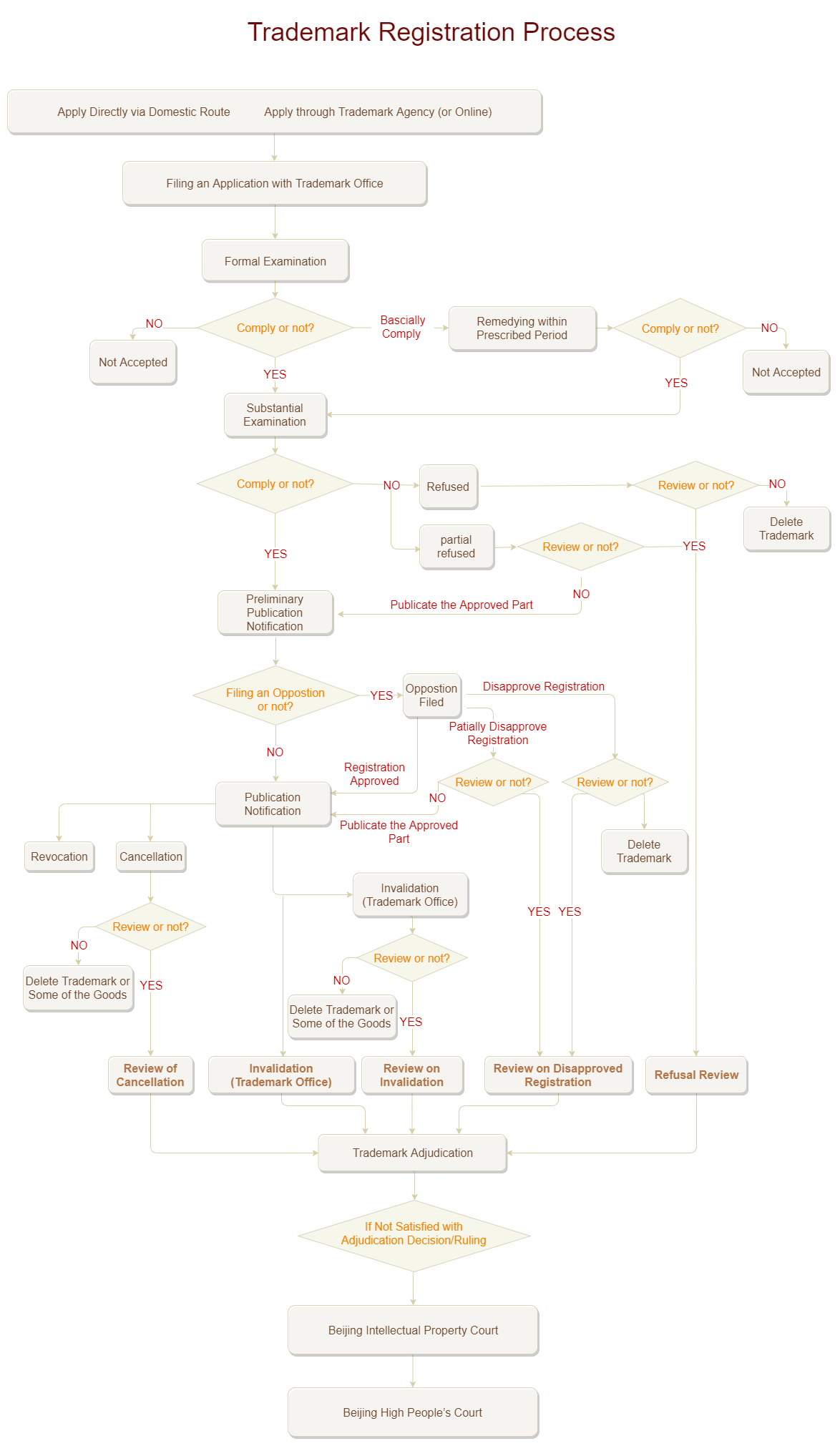中国は世界有数の経済大国として台頭し、世界のビジネスにとって極めて重要な市場となっています。知的財産、特に商標を保護することは、中国市場で事業を営む、または中国市場に参入する企業にとって最優先事項です。本ガイドでは、中国における商標制度について、法的基礎知識、出願ルート、種類、費用、出願プロセス、異議申立、無効、取消について詳しく解説しています。
中国における商標の法的基礎
中国の商標制度は、現地の経済的・文化的ニーズに対応しつつ、国際基準に合致するよう設計された包括的な法的枠組みの下で運用されています。以下はその主要な要素である:
国内法:
- 中華人民共和国商標法:1982年に制定されたこの法律は、中国における商標の登録、使用、保護、管理について規定しています。経済慣行や国際公約の変化を取り入れるため、何度か改正されている。
- 商標法実施細則:これらの細則は、出願、審査、異議申立、権利行使を含む様々な商標関連事項に関する詳細な手続きガイダンスを提供している。
- 不正競争防止法:この法律は、会社名、個人名、ドメイン名、商品名、パッケージ、その他のシンボルなど、他人のよく知られているが登録されていない商標の不正使用などの不正競争行為に対処することで、商標の保護を補完するものです。
国際法:
- 工業所有権の保護に関するパリ条約:加盟国として、中国は外国人申請者に以下の権利を与える。 同保護 国内志願者として。
- マドリッド協定及び議定書:国際出願人は、合理化されたプロセスを通じて、中国を商標保護のために指定することができる。
- TRIPS協定(知的財産権の貿易関連の側面):中国のTRIPS遵守は、世界貿易機関(WTO)が要求する知的財産権の保護と執行の最低基準を保証するものである。
保護原則:
- 先願主義:中国における商標権は、先行使用に関係なく、最初に商標を出願した出願人に付与される。
- 善意の原則:出願人は、他人の権利を侵害する悪意がなく、誠実に商標を出願することが求められます。
中国における商標の種類
中国国家知識産権局(CNIPA)が管轄する中国の商標制度は、以下の種類の商標を認めている:
- 単語マーク:文字、数字、単語を含む。
- 図形的マーク:ロゴ、シンボル、グラフィック要素。
- コンビネーションマーク:言葉とグラフィックのミックス。
- 色の組み合わせ:ブランドを際立たせる特定の色の配置。
- サウンドマーク:ブランドから連想される独特の音。
- 立体(3D)マーク:特徴的な形状やパッケージ。
中国における商標の出願ルート
中国における商標出願には、主に2つのルートがあります:
- 国内出願:直接出願、又はパリ条約の他の締約国への最初の出願・国際公開日から6ヶ月以内の事後出願
- マドリッド方式による領域拡張:出願人の国または地域がマドリッドプロトコルに加盟している場合、国際出願において中国への領域拡張を要求することができます。この方法は、中国を含む複数の国(特に3カ国以上)で保護を求める場合に効率的です。
中国における商標登録の費用
商標登録にかかる費用を理解することは、企業が効果的に予算を立てるのに役立ちます:
- 申請料金:CNIPAは1クラス10項目まで300人民元。追加項目はそれぞれ30人民元です。詳しくは中国商標出願費用をご覧ください。
- 専門家費用:商標弁護士や代理人を利用する場合、サービス提供者によっては追加費用がかかる場合があります。
- 更新料(該当する場合):中国における商標登録の有効期間は10年であり、1区分につき500人民元の手数料で10年ごとに更新することができます。
商標出願の期間とプロセス
このプロセスには通常 9+3カ月 出願日から:審査に9ヶ月(詳細は第28条を参照のこと)。28を参照のこと。 中国商標法)、出版まで3ヶ月。このスケジュールには以下が含まれる:
ステップ1:商標調査の実施
出願前に、CNIPA データベースをチェックし、商標がユニークで既存の商標を侵害していないことを確認することが不可欠です。
ステップ2:必要書類の準備
- 申請者情報:法人は営業許可証、個人はパスポート。
- 商標デザイン:BWマークを高画質で表現したもの(色が表示されている場合はカラー画像が必要)。
- 委任状:代理人を通じて提出する場合。
- 優先権主張書類:該当する場合、以前の申請または展示の証明。
ステップ3:申請書の提出
- 出願はCNIPAに直接、または国際登録の場合はマドリッドシステムを通じて行うことができる。
- 正式な料金を支払い、領収書を保管すること。
ステップ4:CNIPAによる審査
- 正式 審査:出願がすべての出願要件を満たしていることを確認する。
- 実体審査:商標の識別性を評価し、既存の商標との抵触をチェックする。
ステップ5:異議申し立てのための公表
承認されると、商標は商標公報に掲載され、3ヶ月の異議申立期間となり、その間に第三者は異議を申し立てることができる。

商標登録が拒絶される一般的な理由
中国における商標出願は、以下のようないくつかの理由で拒絶されることがあります:
相対的な理由
- 既存商標との類似性:提案された商標は、既存の登録商標/出願中の商標と紛らわしいほど類似しているとみなされる(例えば、「スターベイク」対「スターバックス」)。
- 著名商標のクロスクラス保護:例えば、飲料で既に有名な「コカ・コーラ」を衣料品に使用する。
- 先使用権の侵害:第三者の作品や有名人の画像(ヤオ・ミンなど)の無断使用。
- 悪意の出願:例えば、squatting(中国でまだ登録されていない外国のブランドをコピーすること)、hoarding(転売のためだけに商標を登録し、使用する意思がないこと)など。
絶対的根拠
- 識別性の欠如:商標が一般的すぎる(例:薬の「Aspirin」)、または記述的すぎる(例:ケーキの「sweet」)ため、商品やサービスを区別できない。
- ネガティブな社会的影響:例:「ギャングスター」、「チンピラ」。
- 誤解を招く用語:例えば、果物に対する認証のない「オーガニック」。
- 宗教的または文化的無神経:宗教的シンボル(仏像、十字架など)を許可なく直接使用すること。
再試験
拒絶に直面した申請者は、拒絶に納得できない場合、CNIPAに再審査を求めることができる。
再審査には 9ヶ月 第34条)。
中国における商標異議申立
利害関係者は、3ヶ月の公示期間内に、以下の理由を理由に異議申し立てを行うことができる。
反対理由
- 先の登録商標(Art.30)/公表商標(Art.30)/出願商標(Art.31)/使用商標(Art.32)との類似性。
- 先の権利(意匠、著作権など)を侵害する(第32条)。
- 事前関係がある不法占拠(第15条)。
詳しくはこちらをご覧ください。 中国商標法.
反対派への対応
申請者は30日以内に証拠と反論をCNIPAに提出することで対応しなければならない。
反対運動の期間
このプロセスには通常 12ヶ月 発行日から(第35条)。
商標の無効化
第三者またはCNIPAは、異議申立と同様の理由で無効審判を請求することができますが、無効審判は公告後の登録商標に限られ、登録日から5年以内に請求することが望ましいとされています。
反対運動の期間
このプロセスには通常 12ヶ月 請求日から(第45条)。
商標の取り消し
誰でもCNIPAに商標の取消を請求できるのは、その商標が3年連続して中国で使用されていないという理由のみである。
キャンセル期間
このプロセスには通常 9ヶ月 請求日から(第49条)。
TMの保持に直面している申立人または取消に直面している所有者は、拒絶に満足しない場合、CNIPAに再審査を求めることができる。再審査にはさらに 9ヶ月 通常(第54条)。
詳細情報
についてもっと見る 中国特許制度の概要
についてもっと見る 著作権登録と保護の包括的ガイド中国にて
中国商標制度に関する専門的なガイダンスとサポートが必要な場合は、今すぐ弊所までご連絡ください。

